Plant with adzhika in chlorella broth or what to eat on the way to Mars
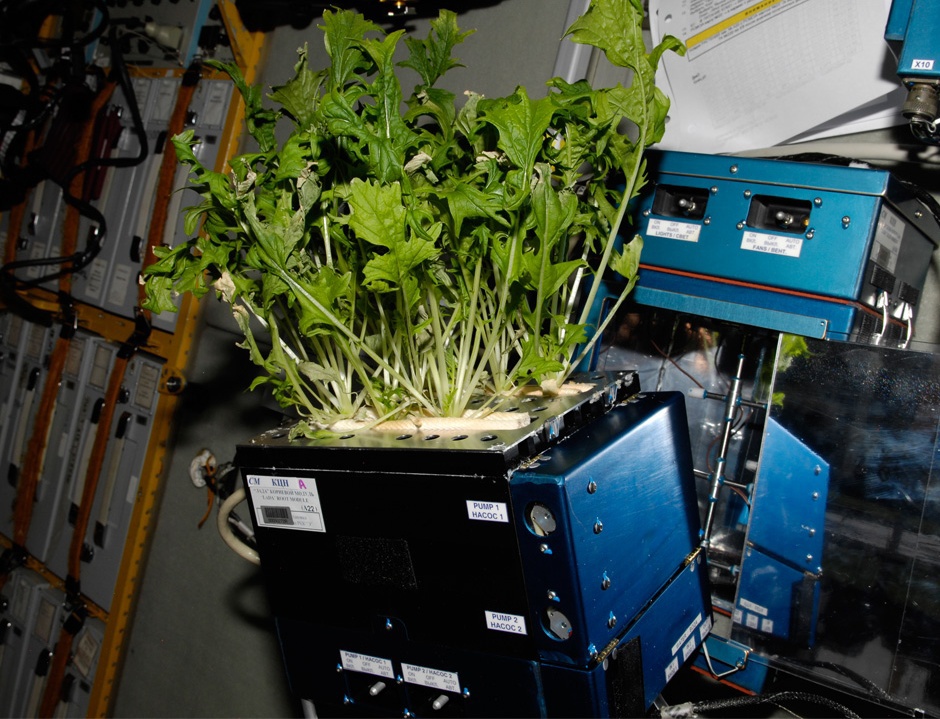
The current state of rocket engines tells us that the road to Mars will be a long one. A flight along a ballistic trajectory without switching on the engines will take about two years, and electrojet engines having a small thrust will not be able to significantly shorten the flight period. In such circumstances, the list of important issues is the organization of food. Food, unfortunately, has a weight that needs to be accelerated to Mars, the crew produces waste that needs to be thrown away or recycled, in general, this engineering creates a lot of various engineering challenges. We will talk about them.
Space food history
The food currently used on the ISS is slightly different from the usual terrestrial one. Canned food, sublimated products, with a cargo ship bring fresh fruit. Is that the quality is guaranteed and canned, certainly not overdue. Such food is, of course, tasty and nutritious, it is diverse, contains few delicacies and is well perceived from the point of view of psychology. But it is not very effective in terms of maximum weight and volume savings for long flights. But first, let's look at her story, what changes she has undergone, and how she has become what she is.
First experiments
The main factor that was taken into account by the developers of space food on both sides of the ocean was weightlessness. The food should not crumble, spill or crumble so as not to cause a short circuit. Therefore, the decisions that in the USSR, in the United States were the same - nekroshayuschiysya bread (in the US it was covered with a special mixture against crumbs), packaged in plastic in small pieces and mashed potatoes in tubes:
')
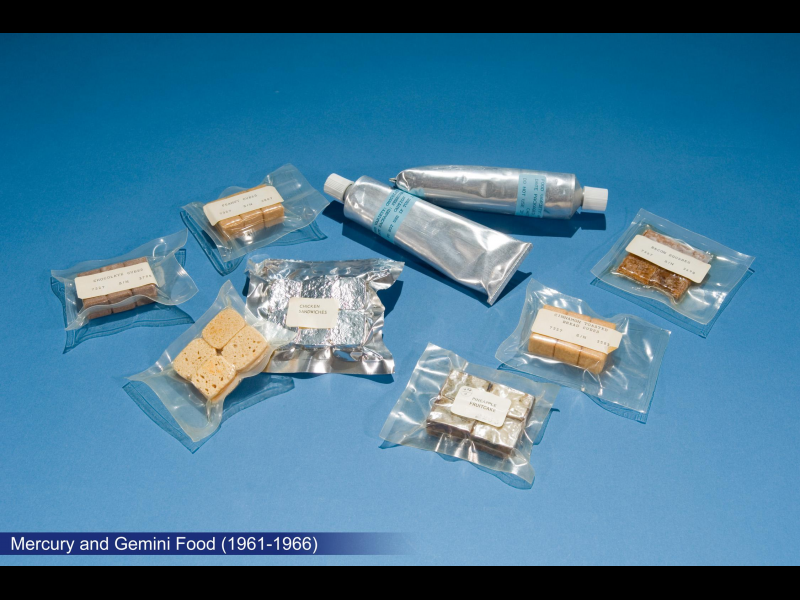

The decision was so-so. Firstly, after acquaintance with weightlessness, it turned out that it is not so terrible. About the forces of surface tension, the developers of food, apparently, have forgotten. Because it is they who guarantee that the water will not crumble into thousands of drops to make short circuits, but it will be quite cultural to hang with a ball, which can already be controlled. Even rice can be eaten in zero gravity, even with a spoon, almost like on Earth, if you glue it with a sauce. Secondly, the nutritional value of this food was insufficient. Despite the calculations of calories, astronauts complained of hunger. Thirdly, the food was not particularly tasty. The fatty shell of the US sandwich cubes spoiled the taste, and the mashed potatoes were devoid of the texture of a “normal” meal and resembled a sauce. The longest flight on such a meal was two weeks (Gemini-7) and demanded a certain amount of willpower from the astronauts.
Sublimation and dilution
Sublimation technology has become extremely useful for space. In physics, sublimation is the transition of a substance from a solid to a gaseous state. If we freeze the food and place it in a vacuum chamber, the water ice will evaporate, bypassing the liquid phase. Products will retain their shape, smell, color, and beneficial substances. The food dried in this way can be placed in plastic, diluted in space with hot or cold water and get good nutrition.

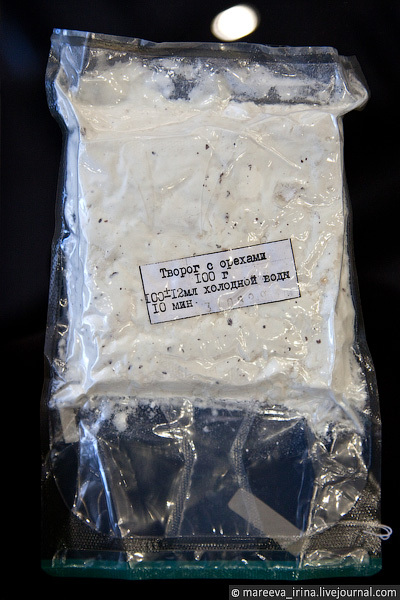
In the USSR, ordinary canned food in cans was added to sublimated products.
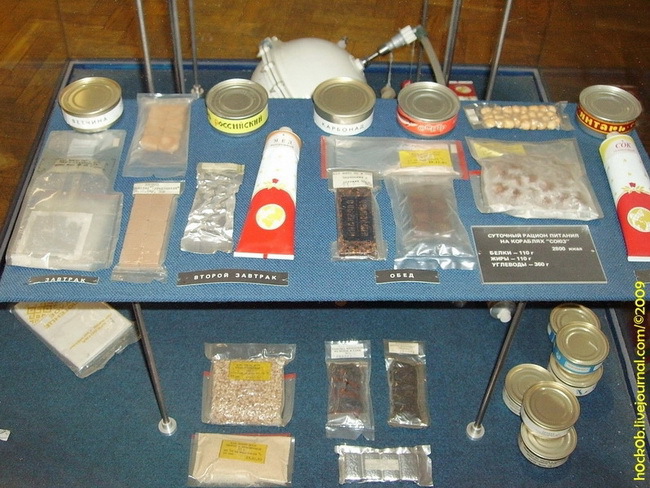
Rations of this type flew on American "Apollos" and Soviet "Unions".
Orbital station wealth
At the orbital stations there was more space, it was possible to hang at the table with its own tray of food. The diet remained virtually unchanged. Is that at the station Skylab wanted to add table wine to the menu, but due to public outrage, these plans were canceled:

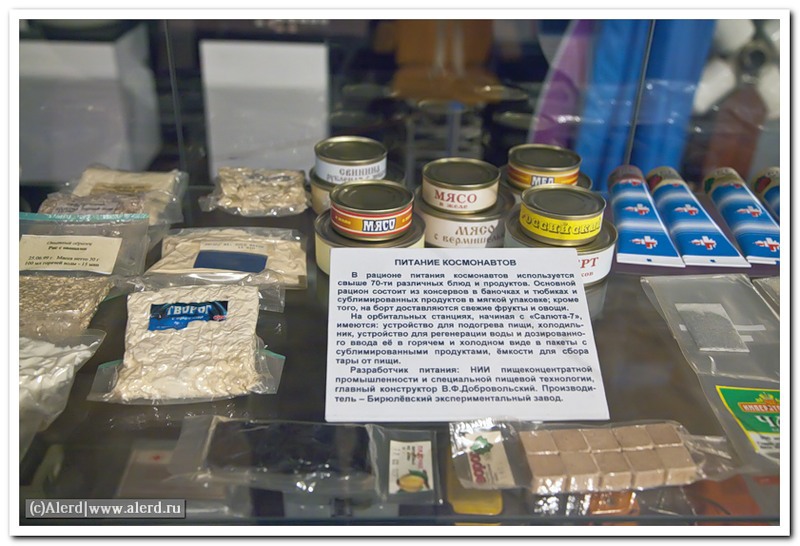
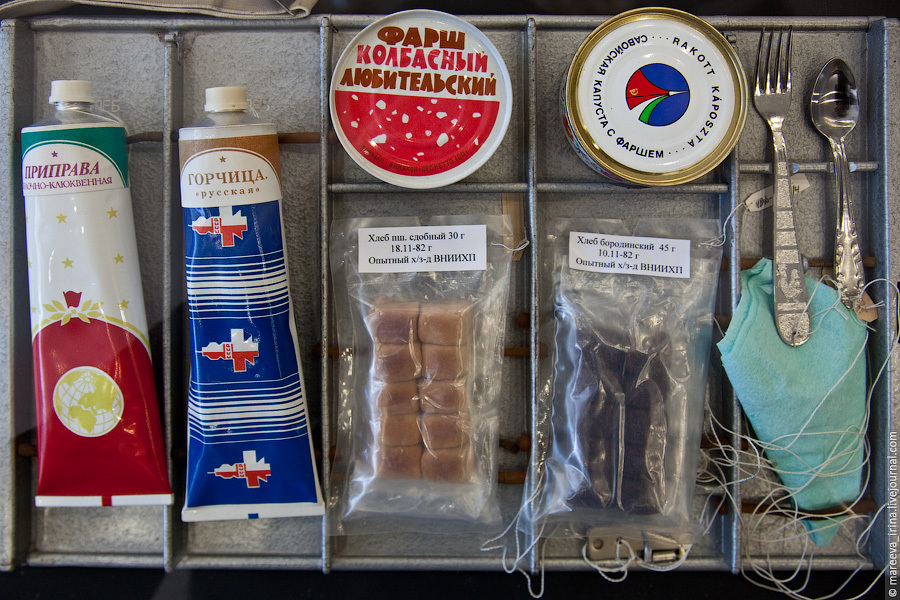
Shuttles and ISS
Modern food is built on the same principles. The ration is made up of freeze-dried products, common canned food (Americans in bags, we have in cans), bread (in the US, nekroshayaschiesya cake, we have - portioned bread), cookies and sweets, as well as dry drinks or tea bags in plastic.

Canned with heat treatment in packages
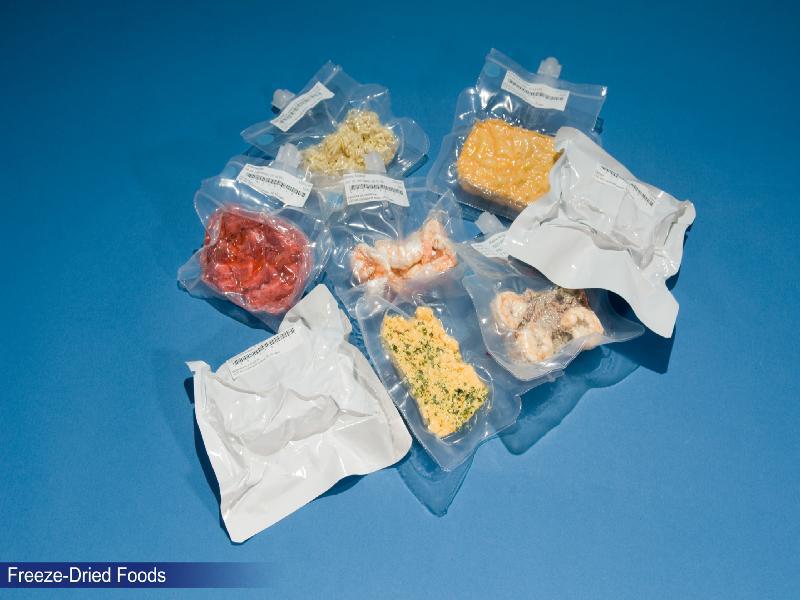
Sublimated Products

Sauces, Cookies, Chocolate
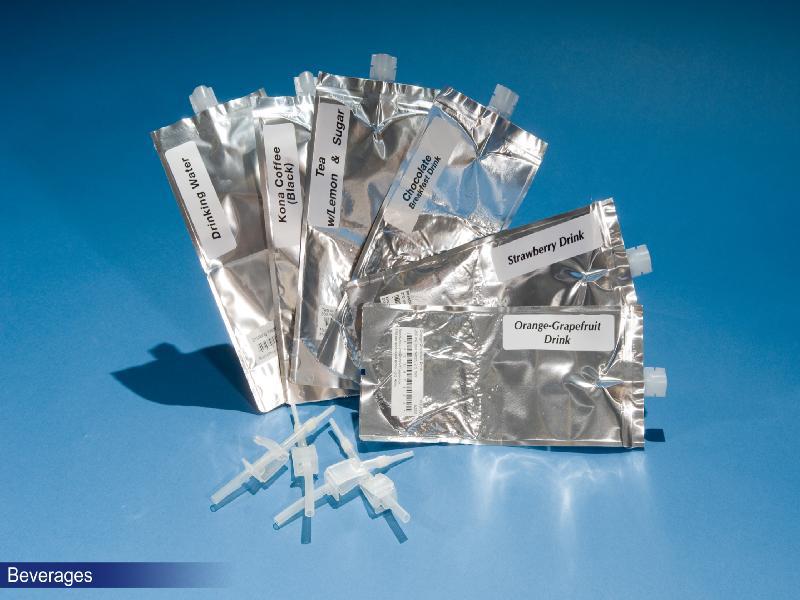
Packaged drinks
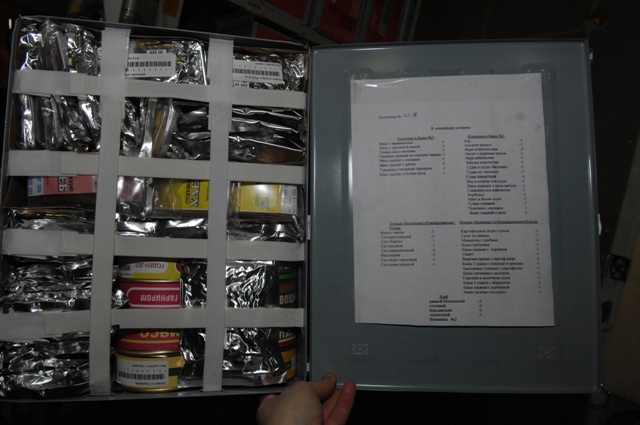
Box with the Russian diet. Differs in canned food in banks instead of packages and national cuisine - we probably have more tea in drinks.
results
Of course, not all types of products are on the ISS, and astronauts sometimes miss dumplings or fried potatoes, but in general the food is not very different from the earthly one. But it has its price - the food weighs a lot, another part of the weight adds packaging. In 2013, 4 “Progress” went to the ISS, one by one by HTV, ATV, Dragon and Cygnus. Those. Approximately 4 * 2500 + 6000 + 5500 + 3300 + 2000 = 26800 kg of cargo were delivered to orbit. Of course, not all of this food, but about 15 tons of food and water were brought to the ISS. If we fly to Mars for two years, then the mass will be about 30 tons. Frankly, the numbers are unpleasant. Are there any ways to reduce this load? Scientists from all over the world have thought a lot about it.
Alternative diets
Even before the first manned space flight, various people and organizations developed food programs for space flights. There have been a lot of such programs: liquid diets (milkshakes, Egnog diet), nutritious sticks, cubes and balls, but all of them were distinguished by the fact that they did not perform well on tests. It must be said that the people participating in these tests showed heroism almost more than the astronauts, because they had to eat these experimental diets longer than the space flights of that time.
Unrestrained imagination drew more and more exotic ideas - mouse farms as a source of meat, edible paper, clothes and details of a spacecraft, but this did not even reach the experimental stage.
Closed loop
The idea of using a closed-loop life-support on a ship is aloof. Plants / algae consume carbon dioxide and crew waste, and release oxygen and produce food. In theory, this is the most profitable option. But, of course, attempts at real incarnation faced various problems.
Chlorella let down

Scientists and fiction put a single-cell alga Chlorella on the throne of the life-support system of a closed cycle. Indeed, unpretentious, living in puddles and ditches, the alga produces oxygen and multiplies, requiring only water, light, carbon dioxide and some minerals. Chlorella is theoretically more nutritious than wheat, as it contains 45% protein, 20% fat and 20% carbohydrates. But all these dreams turned out to be broken by the fact that Chlorella is not absorbed by humans - too dense a cell wall is inaccessible for splitting by human enzymes. In principle, modern technology can offer at least three ways to solve this problem: splitting the cell wall using technological methods (heat treatment, fine grinding or something else), biological methods (take enzymes that split the wall and add them to food) or withdraw GMO chlorella with an accessible wall for fission. Unfortunately, at present, some commercial work with chlorella is carried out only by commercial firms that sell it as dietary supplements ( Wikipedia article , edited in summer 2013) or as an additive for animal husbandry, which is rather sad in terms of providing space flights.
Moral issue
At the “Astronautics News” forum, I once read such a post as an MCC employee (cite from memory): “Hard working day - fans of the closed life-support chain came running, fed everyone with recycled urine, fortunately, I was able to quietly escape.” Alas, the need to drink recycled urine causes psychological rejection, which will complicate and so psychologically difficult long flight. The system that regenerated water from water exhaled with air and other condensate is perceived normally, therefore the SRV-K (condensate water recovery system) worked from the first Salyut orbital stations and now stands on the ISS. But SRV-U (the system of water recovery from the urine) stood only at the Mir station, and on the ISS recycled water from the urine goes to electrolysis and oxygen is obtained from it for respiration.
Successful experiments
At the same time, in the USSR there were quite successful experiments on closed systems: BIOS-2 and BIOS-3. BIOS-3 was launched in 1972 and is operational today (there is a report for 2012 on the site, there is no news about the closure on the Web). Initially, the project had four sealed compartments (two phytotrons for growing plants, one cultivator for algae - atmospheric regeneration and a living compartment) with a total volume of 315 m ^ 3. A wide range of specially selected plants (wheat, soybeans, lettuce, chufa, carrots, radishes, beets, potatoes, cucumbers, sorrel, cabbage, dill, onions) were grown in phytotrons and experiments were conducted on “autonomous flight” lasting up to six months. The results are impressive - almost 100% closed cycle was achieved in air and water, 50-80% in food. The complex survived the restructuring and nightmare of the 90s, and, according to the information on the official website, it is being modernized and takes part in international programs.
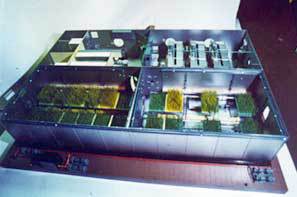
General view of the complex

Phytotron
findings
In general, in terms of providing food for a long expedition, humanity has quite good positions. Even at the level of technology of the 70s and 80s, the BIOS-3 experiment is encouraging, and the spread of the technology of gene modification can give us even more efficient space plants. Also constantly working with plants on the ISS.
Additional materials
A very interesting film "Life Support Paths in Space", examines both physical and chemical (SRV-K, U) and biological (BIOS-3) methods.
The recent release of the program "Astronautics". It is worth noting the positive effect of working with plants on the psyche and rejoice in the younger generation, which seeks to work in this direction in the future.
“Space Odyssey, Century XXI”, food issues from 14 minutes.
International Center for Closed Biological Systems, BIOS-3 website
Chemical regeneration systems, NIIhimmash
Source of photos of NASA food , I recommend to see the photos in large size, visible bilingual signatures of product names and instructions for use.
More photos of modern food on the ISS
For photos of food from museums, thanks to bloggers whose copyrights are shown in photos.
I recommend to read the book "The Other Side of Cosmonautics" by Mary Roach. About the food there at the very end, very curious.
They say there is another book, The Astronaut Cookbook, but I have not read it, I can not say anything.
Source: https://habr.com/ru/post/223211/
All Articles